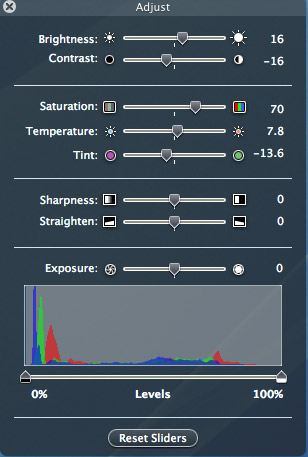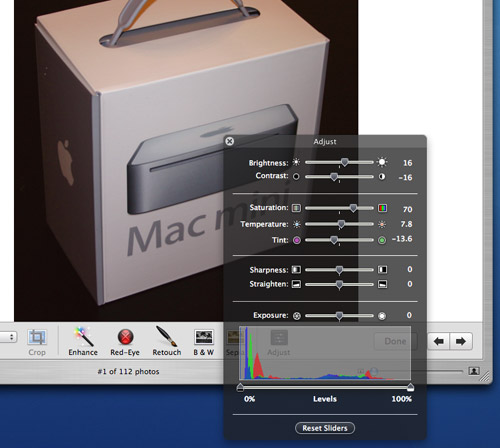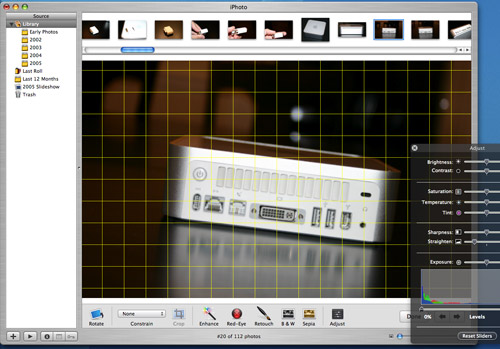Apple's Mac mini - Tempting PC Users Everywhere
by Anand Lal Shimpi on January 25, 2005 7:39 AM EST- Posted in
- Mac
Editing Images with iPhoto 5
If you double-click on any image in iPhoto, you are essentially dropped into an Edit mode. Getting back and forth between the edit mode and the browsing mode is much simpler in iPhoto 5 than it was in 4. Just hit the Done button and you're back to browsing without the editing tools. But the real benefit of iPhoto 5's editing mode is that you now have all of your images at the top of the window for you to scroll through, instead of having to go back to browsing mode and then re-enter editing mode. You can also scroll left and right using the arrow keys at the bottom right corner of the window.
Given that it is designed for the type of photo editing that the vast majority of digital camera owners will be doing, the editing controls in iPhoto 5 aren't too surprising. You have an easily accessible row of buttons at the bottom of your picture window, so there's no going to a separate tool box or pulling down another menu.
The first one is rotate, which is self-explanatory. The next tool is a drop-down for dimensions (or ratios) to constrain the image canvas to prepare it better for printing; and next to that drop-down, the crop button that will finish the deed.
![]()
Then, there are the usual buttons: enhance, red-eye reduction, a retouch brush, B&W and sepia filters. And then the most important button - the Adjust button.
Hitting the adjust button brings up a translucent dashboard that has sliders to adjust the following items: brightness, contrast, color saturation, color temperature, tint and sharpness. There are also sliders to straighten the image as well as adjust the exposure and crop out the high/low color levels of the picture.

All of the sliders work in real time and for the first time, I found myself actually adjusting things like color saturation and temperature on a regular basis for the images that I imported into iPhoto. It was just so easy, since all of the useful controls were all presented for you right there.

The straighten slider is particularly neat because as soon as you start moving it, a grid appears over the image to help guide your image straightening - one of the most useful features of iPhoto. For the first time, I actually had straight images without spending a lot of time on them.

Straightening a photo in iPhoto 5
Editing images in iPhoto is very easy, but unfortunately, not a Photoshop replacement for me. The problem is that saving (exporting) images from iPhoto is a bit of an ordeal compared to doing a simple Save As under Photoshop.
![]()
The application is clearly designed for the needs of your normal digital camera enthusiast. You can easily email the photos, print them, make them into a book (which you can then order printed and made from Apple directly within the application) or even order prints using the integrated Kodak Print Service (also built-in directly to the application). However, for web publication on a site like AnandTech where photos need to be ftp'd over, iPhoto does lose some of its appeal. So for my needs, iPhoto is faster in some cases, but I can't get rid of Photoshop all together. For example, iPhoto won't let me do a custom resize of an image that doesn't scale the length and width by the same proportions, something that is sometimes necessary for our front page graphics. While iPhoto 5 produced all of the images for this article, one required launching Photoshop. The one thing that I did like about iPhoto's file export is that you can give it width and height constraints for the images and it will handle all resizing for you. Unfortunately, it doesn't always stay within those bounds if you have images of varying sizes in the selection that you're exporting.
For management of your pictures of friends, family and your hobbies, iPhoto works wonders, but it does leave me wishing that there was a more professional version of iPhoto that would add features like non-constrained sizes and ftp export. I'd like to be able to replace Photoshop completely, simply because it's too expensive of an application and too feature-filled for the needs that I have; unfortunately, iPhoto wasn't the complete replacement that I was looking for, although it came extremely close.










198 Comments
View All Comments
elvisizer - Tuesday, January 25, 2005 - link
stylex, the mini uses regular pc2700 ddr ram. nothing special about it.egilDOTnet - Tuesday, January 25, 2005 - link
And one more thing - regarding Office compability - I thought that the Appleworks package still was included with the Mac mini?? Is this not so anymore, Anand, or did you just forget about that?elvisizer - Tuesday, January 25, 2005 - link
#16 and #12- yes, it's true that if you don't have those items already you'll have to spend money to buy them. So what? if you don't have them sitting around, then the mini isn't as good a deal for you. The point is, for the vast majority of people buying one, a mini will not end up costing $1000. it'll end up costing $499+ 1 memory upgrade.also, there's one error in the article- anand says that TextEdit can't open Word documents. that's not true. TextEdit has been able to open and edit Word documents since 10.3 came out.
egilDOTnet - Tuesday, January 25, 2005 - link
Just wanted to chime in on one thing - exporting images from iPhoto - you know that you can just select images, and then drag them out on the desktop or wherever you want them to be copied??Good article!
bupkus - Tuesday, January 25, 2005 - link
I'd like one just to take it for a ride. I wholely support the idea of SFF and this certainly takes the "S" seriously. As to using less energy, 85W is probably as good as it gets.This is the first I've heard of AMD's mini-itx which uses Windows CE. I wonder if that means it's much more vulnerable to malware than the "mini". Sure it costs more than something like the Biostar IDEQ 210V, but if the "mini" means less free tech support to relatives who just web surf, I'd recommend it.
miketheidiot - Tuesday, January 25, 2005 - link
#30 most people are still very computer illiterate. They also don't buy them because of their compatability or upgradability. They buy on cost alone and name. Apple has a name (whether a good or bad name is a matter of opinion) and now they have the price. I see no reason why these won't sell.bigpow - Tuesday, January 25, 2005 - link
>2) Sure you get better graphics with the mini and a better optical drive, but you get more memory and a faster hard drive with the Dell.Oh yeah... riiiight!
Better graphics because you're imagining the picture! Dell comes with 15" LCD, Mac comes with your imagination.
Nice comparison, duh!
Jeff7181 - Tuesday, January 25, 2005 - link
I still think these titles that suggest the MiniMac will steal marketshare from the PC is rediculous. People don't use PC's because they're they come in the smallest form factors. They use them because of their compatability, upgradability, and cost. Apple has only scratched the cost issue with the MiniMac... but most PC users will avoid a Mac simply so they don't want to learn to use a computer all over again... for some people that's not an easy thing to do.ehanneken - Tuesday, January 25, 2005 - link
Stylex, Crucial's Mac page is http://www.crucial.com/mac/index.aspYou would actually pay more to buy a 512 MB DIMM from Crucial than you would to upgrade the Mac Mini to 512 MB when you purchase it. On the other hand, you would end up with two DIMMs instead of one.
jasonsRX7 - Tuesday, January 25, 2005 - link
#23 - Nail on the head :)#25 - Apples prices to add ram to the mini are reasonable. $75 to upgrade to 512mb, less if you're a student.